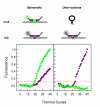Molecular beacon-based real-time PCR detection of primary isolates of Salmonella Typhimurium and Salmonella Enteritidis in environmental and clinical samples
- PMID: 19454003
- PMCID: PMC2689230
- DOI: 10.1186/1471-2180-9-97
Molecular beacon-based real-time PCR detection of primary isolates of Salmonella Typhimurium and Salmonella Enteritidis in environmental and clinical samples
Abstract
Background: A fast and simple two-step multiplex real-time PCR assay has been developed to replace the traditional, laborious Salmonella serotyping procedure. Molecular beacons were incorporated into the assay as probes for target DNA. Target sequences were regions of the invA, prot6E and fliC genes specific for Salmonella spp. Salmonella Enteritidis and Salmonella Typhimurium, respectively, the two most clinically relevant serotypes. An internal amplification positive control was included in the experiment to ensure the optimal functioning of the PCR and detect possible PCR inhibition. Three sets of primers were used for the amplification of the target sequences. The results were compared to those of the Kauffmann-White antigenic classification scheme.
Results: The assay was 100% sensitive and specific, correctly identifying all 44 Salmonella strains, all 21 samples of S. Enteritidis and all 17 samples of S. Typhimurium tested in this work. Therefore, the entire experiment had specificity and sensitivity of 100%. The detection limit was down to 10 copies of DNA target per 25 microl reaction.
Conclusion: The assay can amplify and analyse a large number of samples in approximately 8 hours, compared to the 4 to 5 days conventional identification takes, and is thus considered a very promising method for detecting the two major serotypes of Salmonella quickly and accurately from clinical and environmental samples.
Figures




References
Publication types
MeSH terms
LinkOut - more resources
Full Text Sources
Other Literature Sources
Molecular Biology Databases
Miscellaneous

